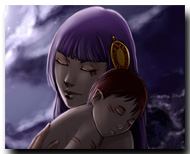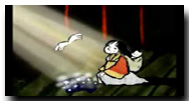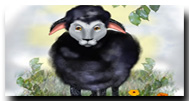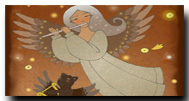Contact Us
LULLABYABC.com
A Lullaby, will take you to your childhood and to your joyful days. Lullaby builds bridges where there are memories and peace.
Peace starts with a lullaby for everybody. Lullaby brings love to a baby as well as happy memories to an adult. Every baby goes to bed hoping for a calm and loving lullaby.
Click on the arrow for examples of Lullabies.
Twinkle Twinkle Little Star
is the most known English/American Lullaby.
All the Pretty Little Horses (or commonly known as "Hush A Bye (Baby))
This Lullaby was originated from an African-American slave woman who lost her baby while taking care of her master`s baby.
Hushabye Mountain
is a popular modern-day Lullaby
Dandini Dandini Dastana
is an old Turkish Lullaby which shows the cultural differences
WHAT IS A LULLABY?
Lullaby: A soothing, quiet, lovely song sung to lull a baby to sleep.

Originally, a vocal piece designed to lull a child to sleep with repeated formulae; less commonly, it can be used to soothe a fractious or sick child.
Like the lament, with which it has much in common, the lullaby is usually (though not exclusively) sung solo by women and displays musical characteristics that are often archaic, such as a descending melodic line, portamento effects, stylized representations of sighing or weeping, and non-stanzaic text lines.
Context and practice are not universally consistent: lullabies can be performed seated while cradling the infant in the lap, as in Samoa, or by the parents swinging the child slowly in an arc between them, as with the Ewe of West Africa. As regards the purpose of lullabies, those of the Hazara of Afghanistan, for example, are categorized as either 'functional' or 'stylized'; the former are sung by women to put small children to sleep, the latter by men for entertainment, often accompanied by a dambura (two-string fretless lute). They may also have more than one function: for the Hazara, lullabies not only send the child to sleep but can also act as a signal to the singer's lover. In the sub-Arctic Algonkian area, the bebe ataushu repertory is predominantly private, women's music. For the Navajo, lullabies are one of a number of non-ceremonial types of traditional song. In Italy, lullabies have been classified as magical (directly involving sleep), erotic (explicit love songs) or di sfogo ('outlet', 'venting'), in which the female singer laments her own or the human condition. Textual analysis of Japanese lullabies suggests a close connection between the manner of performance of lullabies and magic.
Textual formulae and refrains can be used, like 'fatta la ninna' ('rock-a-bye') in Italian lullabies, to ward off evil and invoke divine help, and can vary, in the vowel set of the refrain, within regions of a country such as Spain. They can cross cultural boundaries, as in 'ninna-nanna' (Italy), 'nani, nani' (Albania), and 'ljulja nina' (Bosnia-Hercegovina). Formulae appear again in the imagery and repeated diminutives of a Zuñi lullaby ('little boy, little cotton-tail, little jack-rabbit, little rat'), and melodically, in the same lullaby, with a range of just two notes. The Hazara texts contain the sounds 'lalai' or 'lalu' along with the interjection of terms of endearment such as 'my sweet' or 'my eyes'. The sound effects of the lullaby sometimes take precedence over meaning, with words being deliberately altered to produce assonant, mellifluous sounds. Lullabies among the Tuareg differ from other women´s songs in their more supple style, the use of semitones and a dissymmetric structure subordinate to the demands of improvised texts. The melody invariably moves within a fairly narrow range of a 4th or 5th, but can have, as in Norway, great melodic and rhythmic flexibility within a few common formulae.

The words of the lullaby can instil cultural values or incorporate the fears of the parent.
Imagery involving the wolf in southern Italian lullabies suggests the need to cope with life´s harsh realities; it may also represent violence and dominance. The 'lullaby' can, indeed, convey a plurality of messages in its text and style: one Gaelic-text lullaby ostensibly contains information, sung to another woman washing clothes, about the singer´s abduction by fairies and the breaking of the spell (to be accomplished by her husband). The abducted woman lulls a fairy child to sleep by means of repetitive musical phrases, suggesting to the fairies that all is well. The 'narrative' message is to the other woman. In reality, however, the song itself tells listeners of the woman´s plight. The lullaby text, therefore, can be creatively complex; matched to formulaic snatches of melody it can result in a rich and eloquent musical genre.
The lullaby as a vocal (with or without accompaniment) or instrumental piece appears in art music of all periods; examples are found in medieval carols with 'lullay' burdens, in 18th-century choral music, 19th-century lieder, and 19th- and early 20th-century piano pieces. See Berceuse and Wiegenlied.

Lullaby, as an alternative medicine.
Lullabies are used in pregnancy and birth sessions against pain, morning
sickness and birthing fears and phobias.

Lullaby, as a source of peace and happiness.
Doctors, Child and Developmental psychologists agree on singing is being the best way to regulate children's emotions. Because a mother singing to her baby immediately increases the serotonin levels in child`s brain. Serotonin is well known "happiness hormone"
ORIGINS AND HISTORY
Origins Of The Word Lullaby
The word "Lullaby" is coming as a mix from two different origins. Ancient Jewish and Turkish cultures. One can see the word "Lilith-bye" in old hebrew inscriptions. Lilith, from Jewish mythology was believed to be a female demon who was stealing babies. Jewish people in ancient times used to put four amulets (an ancient item for good luck) on their nursery walls with the inscription "Lilith - abi!" (Lilith - begone)
Ancient, Old and Modern Lullabies
"9th Century Old High German lullaby (Althochdeutsches Schlummerlied)" - "Baa, Baa, Black Sheep" , an English Lullaby of 1761 and In My Arms by Plumb (2007)

"Old High German lullaby (Althochdeutsches Schlummerlied)" - Hand Written in 9th Century
Tocha slafes sliumo / uueinon sar lazzes. - Docke, sleep speedily / leave off crying
Triuua uuerit kraftlicho / themo uuolfa uurgianthemo. - Triuwa forcefully / fends off the murdering wolf
slafes unz za morgane / manes trut sunilo. - May you sleep until morning / dear man's son
Ostara stellit chinde / honak egir suozziu. - Ostra for the child leaves / honey and sweet eggs
Hera prichit chinde / pluomun plobun rotun - Hera for the child breaks / flowers blue and red
Zanfana sentit morgane / ueiziu seaf kleniu, - Zanfana on the morrow sends // white little sheep
unta Einouga, herra hurt! / horska aska harta. - and One-Eye, herra hurt, swift, hard spears
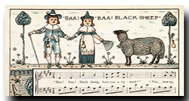
"Baa, Baa, Black Sheep" is an English Lullaby of 1761. Same Melody is used for "Twinkle Twinkle Little Star" and the "Alphabet song".
Original Version
Bah, Bah a black Sheep,Have you any Wool?
Yes merry have I,
Three Bags full,
One for my master,
One for my Dame,
One for the little Boy
That lives down the lane.
Modern Version
Baa, baa, black sheep,Have you any wool?
Yes sir, yes sir,
Three bags full.
One for the master,
One for the dame,
And one for the little boy
Who lives down the lane.

"In My Arms" is the lead single from Plumb's lullaby album Blink. Released in 2007. The song was the 19th most played song on Christian Hit Radio stations in the U.S. in 2007
Your baby blues
So full of wonder
Your curly cues
Your contageous smile
And as I watch
You start to grow up
All I can do is hold you tight
***
Knowing clouds will rage
And storms will race in
But you will be safe in my arms
Rains will pour down
Waves will crash all around
But you will be safe in my arms
***
Story books full of fairy tales
Of kings and queens and the bluest skies
My heart is torn just in knowing
You'll someday see the truth from lies
***
Knowing clouds will rage
And storms will race in
But you will be safe in my arms
Rains will pour down
Waves will crash all around
But you will be safe in my arms
***
Castles they might crumble
Dreams may not come true
But you are never all alone
Because I will always
Always love you
***
Clouds will rage
And storms will race in
But you will be safe in my arms
Rains will pour down
Waves will crash all around
But you will be safe in my arms
Video Examples of Lullabies
AMERICAN LULLABIES
-
Rock-a-bye Baby Even though it was originated from London in 1765, this lullaby is one of the most popular lullabies in US.
-
Twinkle Twinkle Little Star Since the 18th century England, Twinkle Twinkle Little Star was always the most famous Lullaby in English speaking countries.
-
Hush, Little Baby The author and the date are unknown. However Mockingbirds are from American continent. Therefore this Lullaby is believed to be American.
-
All the Pretty Little Horses (or commonly known as "Hush A Bye (Baby))This Lullaby was originated from an African-American slave woman who lost her baby while taking care of her master`s baby.
LULLABIES FROM AFAR
Lullabies in Different Countries
Lullabies in European Countries
Albania | Austria | Bulgaria | Finland | France | Germany | Greece | Iceland | Ireland | Italy | Netherlands | Norway | Poland | Romania | Russia | Spain | Turkey | United Kingdom
Lullabies in Asian Countries
Afghanistan | Arab Countries | Armenia | China | India | Indonesia | Iran | Japan | Kazakhstan | Korea | Malaysia | Mongolia | Pakistan | Philippines | Singapore | Sri Lanka | Thailand | Uzbekistan | Vietnam
Lullabies in African Countries
Algeria | Cape Verde | Ethiopia | Kenya | Morocco | Mozambique | Namibia | Nigeria | Senegal | Somalia | South Africa | Sudan | Swaziland | Tanzania | Togo | Tunisia | Uganda | Zambia | Zimbabwe
Lullabies in South American Countries
Argentina | Bolivia | Brazil | Chile | Colombia | Ecuador | Peru | Uruguay | Venezuela
Lullabies in North American Countries
The Bahamas | Canada | Costa Rica | Cuba | Dominican Republic | El Salvador | Greenland | Guatemala | Haiti | Honduras | Jamaica | Mexico | Nicaragua | United States of America
Lullabies in Rest Of The World
Australia | Eskimo | Aborigine | Native
American | Gypsy |
Arabic
www.lullabyabc.com
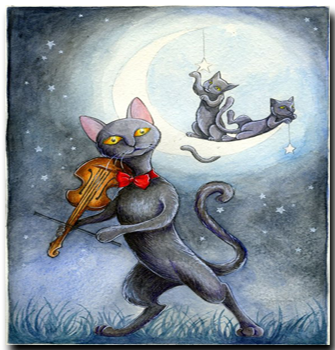
All In One
© LullabyABC.comBecause peace starts with a lullaby










































































